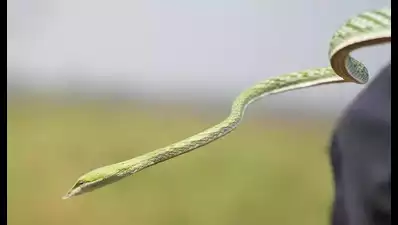- News
- City News
- bareilly News
- Rare snake rediscovered in Dudhwa Reserve, ‘first-ever’ live sighting in country
Trending
Rare snake rediscovered in Dudhwa Reserve, ‘first-ever’ live sighting in country
Bareilly: The rare and elusive Ahaetulla longirostris, commonly known as the long-snouted vine snake, has been recorded for the first time in Uttar Pradesh's Dudhwa Tiger Reserve (DTR), marking only the second documented sighting of the species in India. Previously observed only once in Bihar, this rediscovery underscores Dudhwa's rich biodiversity and highlights the importance of conserving its delicate ecosystems.
The snake was discovered during a rhino release operation in the Palia Kheri division of Dudhwa. As part of safety precautions, a termite mound near the release site was being carefully cleared to prevent any hidden obstacles that could endanger the animal. When an excavating machine lightly touched the mound, a striking green snake emerged, drawing immediate attention.
Ensuring the reptile's safety, Vipin Kapoor Saini, a part of the rehabiliation team, carefully handled the snake, and, along with Apoorva Gupta, Rohit Ravi (senior project officer at WWF-India), and Shushant Singh, released it into a nearby termite mound to provide a secure and familiar environment. Recognising the ecological importance of its habitat, the reserve authorities decided to leave the original termite mound intact.
The discovery marks a significant moment for Indian herpetology and conservation, reinforcing Dudhwa's status as a biodiversity hotspot. The first known record of Ahaetulla longirostris dates back to 2021 when two scientists, Sourabh Verma and Soham Pattekar, found a dead specimen in Bihar's Valmiki Tiger Reserve. Initially unfamiliar with the species, they conducted DNA testing, follow-up surveys, and an in-depth analysis, ultimately confirming that they had inadvertently discovered a new species of vine snake. Their findings were published in a 2024 report.
Highlighting the significance of the find, Rengaraju T, conservator of forests and deputy director of DTR, said, "The rediscovery of Ahaetulla longirostris from the Kakraha Rhino Reintroduction Area-1 in South Sonaripur is a landmark achievement for Indian wildlife conservation. Previously recorded only in Bihar, this marks the second confirmed sighting in India and the first-ever in Dudhwa. This event highlights the critical role of even the smallest ecological components, such as termite mounds, which often go unnoticed but serve as vital microhabitats for rare species. Their conservation is as essential as protecting larger wildlife species."

About the Author
Kanwardeep SinghEnd of Article
FOLLOW US ON SOCIAL MEDIA











